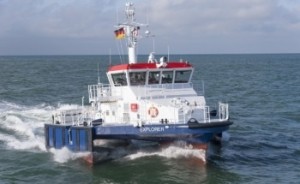One of the world’s most advanced pilot boats contains a hybrid drive from Siemens. Called the Explorer, the vessel is a SWASH (Small Waterplane Area Single Hull) vessel with a torpedo-shaped float located centrally  underneath the hull. The boat’s propulsion system is also located in this tube. The vessel remains stable in the water even in rough seas and is relatively light, thus reducing fuel consumption. The hull contains a flexible and compact EcoProp Hybrid system, which ensures efficient and environmentally compatible operation in both the diesel and the electric mode. The hybrid drive system is economical in all operational profiles. The diesel engine is used to propel the boat. Surplus energy can be used by a generator to supply the vessel with electricity. The boat is currently being tested on the Elbe River.
underneath the hull. The boat’s propulsion system is also located in this tube. The vessel remains stable in the water even in rough seas and is relatively light, thus reducing fuel consumption. The hull contains a flexible and compact EcoProp Hybrid system, which ensures efficient and environmentally compatible operation in both the diesel and the electric mode. The hybrid drive system is economical in all operational profiles. The diesel engine is used to propel the boat. Surplus energy can be used by a generator to supply the vessel with electricity. The boat is currently being tested on the Elbe River.
The Explorer is a further development of SWATH (Small Waterplane Area Twin Hull) craft, which have two torpedo-shaped floats underneath the water. These kinds of vessels are less susceptible to wind and waves than other designs so that pilots can safely go from the boat to the ship they have to direct even in rough seas. In the Explorer, the two lateral floats are replaced by a single tube in the middle. The boat has two outriggers at the sides to keep it stable. The new design makes the vessel lighter and more agile. Good maneuverability is important because the pilot boat and the ship to be directed have to maintain their relative positions when the pilot is transferring between the two. The speeds can be fairly high, and the large container ships on the Elbe River travel at eight or more knots, for example.
The Explorer’s EcoProp Hybrid propulsion system is based on the ELFA drive system that was originally developed for buses. At the heart of the system is an electrical machine that can serve either as a motor or a generator. When the boat is being propelled by the diesel engine, the latter also supplies energy to the generator. If electric operation is selected, the propeller is instead driven by the electric motor. In this mode, the boat can attain one third of its top speed of 17 knots (approximately 31 kilometers per hour).
The boat’s ability to travel a longer distance solely on electricity is important for a number of reasons, including the fact that the centrally located float only contains a single diesel engine. However, some applications require a second propulsion system to be on board for safety reasons. In the Explorer, this role is performed by the electric motor.
ELFA hybrid drives power urban buses in cities all over the world, including London, Munich, and Hanoi. Siemens adapted the components to the special conditions found on the high seas so that the system would be suitable for maritime use and to obtain certification from Germanischer Lloyd SE.






